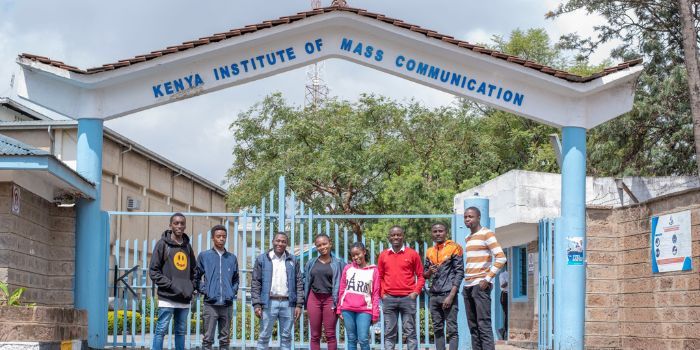The Kenya Institute of Mass Communication (KIMC), located along Uholo Road, off Mombasa Road in Nairobi County, is a leading Technical and Vocational Education and Training (TVET) institution under the Ministry of Information, Communications, and Digital Economy. Established in 1961 as the Voice of Kenya Training School, KIMC has evolved into a premier media training hub, equipping students with practical skills in journalism, film production, public relations, and electrical engineering. With over 5,000 students and partnerships with institutions like the University of Nairobi, KIMC is renowned for producing graduates who excel in Kenya’s dynamic media industry and beyond. This article provides a detailed overview of the eight courses offered for the 2025/2026 academic cycle, admission requirements, career prospects, and why KIMC is a top choice for aspiring media professionals.
Why Choose Kenya Institute of Mass Communication?
KIMC’s strategic location in Nairobi, the heart of Kenya’s media and communication industry, and its focus on hands-on training make it a standout institution. Here’s why KIMC is a preferred choice:
- Accreditation: KIMC is registered with the Technical and Vocational Education and Training Authority (TVETA) under license TVETA/PUBLIC/TVC/0005/2016 and accredited by the Kenya National Qualifications Authority (KNQA).
- Industry-Relevant Training: Programs are examined by the Kenya National Examinations Council (KNEC) and TVET-CDACC, ensuring alignment with industry standards in media and engineering.
- Modern Facilities: KIMC boasts state-of-the-art studios for radio, TV, and film production, alongside advanced electrical engineering workshops.
- Collaborations: Partnerships with the University of Nairobi, Commonwealth of Learning (COL), and regional media organizations enhance training quality.
- Practical Focus: KIMC emphasizes hands-on training, preparing graduates for immediate employment or entrepreneurship in media and related fields.
This guide details the eight programs listed by the Kenya Universities and Colleges Central Placement Service (KUCCPS) for the 2025/2026 cycle, alongside additional courses offered by KIMC, based on available data from its website and other sources.
Courses Offered at Kenya Institute of Mass Communication for 2025/2026
KIMC operates through five academic departments: Film/Video Production Training, Broadcast Journalism, Print Journalism, Advertising and Public Relations, and Engineering Training. The following eight diploma programs are offered for the 2025/2026 cycle, as listed by KUCCPS:
1. Film/Video Production Training Department
This department trains students in film and video production, focusing on specialized roles in the creative industry.
- Diploma in Film/Video Programmes Production (Sound Option) (1710558): Covers sound design, recording, and editing for film and TV productions. Graduates work as sound engineers or audio technicians.
- Duration: 2–3 years
- Examination Body: KNEC
- Diploma in Film/Video Programmes Production (Directing Option) (1710605): Focuses on directing techniques, script development, and production management for film and TV.
- Duration: 2–3 years
- Examination Body: KNEC
- Diploma in Film/Video Programme Production (Lighting Option) (1710J01): Trains students in lighting design and setup for film and video productions.
- Duration: 2–3 years
- Examination Body: KNEC
- Diploma in Film Costume Design and Makeup Artistry (1710J02): Covers costume design, makeup artistry, and special effects for film and theater.
- Duration: 2–3 years
- Examination Body: KNEC
2. Advertising and Public Relations Department
This department equips students with skills in strategic communication and creative advertising.
- Diploma in Public Relations and Creative Advertising (1710628): Focuses on public relations strategies, media campaigns, and creative advertising techniques. Ideal for roles in PR firms and corporate communications.
- Duration: 2–3 years
- Examination Body: KNEC
3. Engineering Training Department
This department offers technical programs in electrical and electronics engineering, tailored for media and communication applications.
- Diploma in Electrical & Electronics Engineering (Telecommunication Option) (1710717): Covers telecommunication systems, broadcasting equipment, and network maintenance for media houses.
- Duration: 2–3 years
- Examination Body: KNEC
- Diploma in Electrical and Electronics Engineering (Instrumentation Option) (1710817): Focuses on instrumentation and control systems for industrial and media applications.
- Duration: 2–3 years
- Examination Body: KNEC
- Diploma in Electrical & Electronics Engineering (Power Option) (1710917): Trains students in power systems and electrical installations for media infrastructure.
- Duration: 2–3 years
- Examination Body: KNEC
Additional Courses Offered
Based on data from KIMC’s website and other sources, the institute offers additional programs not listed in the KUCCPS 2025/2026 cycle, including postgraduate, diploma, and certificate courses:
- Postgraduate Diploma Programs:
- Postgraduate Diploma in Mass Communication: Advanced training in journalism and media production (1 year, requires a bachelor’s degree).
- Postgraduate Diploma in Film Studies: Specialized training in film production and analysis (1 year, requires a bachelor’s degree).
- Diploma Programs:
- Diploma in Journalism: Covers print, broadcast, and digital journalism (KNEC, 2–3 years).
- Diploma in Radio Programs: Focuses on radio production and presentation (KNEC, 2–3 years).
- Diploma in Television Programs: Trains students in TV production and broadcasting (KNEC, 2–3 years).
- Diploma in Animation and Digital Media: Covers digital animation and multimedia production (TVET-CDACC, 2 years).
- Certificate Programs:
- Certificate in Film Programs: Entry-level training in film production (KNEC, 1–2 years).
- Certificate in Radio and Television Presentation Techniques: Basic skills in radio and TV presenting (KNEC, 1 year).
- Certificate in Media Technology: Foundational skills in media equipment operation (KNEC, 1 year).
- Short Courses and Workshops:
- Photography and Photojournalism: Covers professional photography techniques (3–6 months).
- Graphic Design: Training in design software for media applications (3–6 months).
- Script Writing: Focuses on scriptwriting for film and TV (3 months).
- Camera Operations: Practical training in camera handling (3 months).
Admission Requirements for KIMC Courses
Entry requirements are set by the Ministry of Information, Communications, and Digital Economy, aligning with TVETA and KNEC standards:
- Diploma Courses (KIMC and KNEC-Examined):
- Minimum KCSE mean grade of C plain.
- Specific subjects: C plain in English and Kiswahili for media-related courses; C plain in Physics/Physical Sciences or C- in Electricity/Drawing and Design for engineering courses.
- Certificate Courses:
- Minimum KCSE mean grade of C- for KNEC-examined programs; D+ for TVET-CDACC programs.
- Relevant artisan qualifications may be considered for advanced entry.
- Postgraduate Diploma Courses:
- Bachelor’s degree in a relevant field (e.g., journalism, media studies, or engineering).
- Minimum of 3 years’ experience for technical programs like Media Technology.
- Short Courses:
- Vary by program; typically require a certificate or diploma in a related field or relevant experience.
- Additional Requirements:
- National ID or birth certificate.
- Certificate of Good Conduct.
- Two passport-size photographs.
- Application fee: KES 1,000 for Kenyan citizens, USD 50 for international students.
Applicants must submit:
- KCSE/KCPE result slips or equivalent certificates.
- Completed application form (available at kimc.ac.ke).
- Copies of national ID (both sides) and school leaving certificate.
- Bankers’ cheque or proof of application fee payment.
How to Apply to Kenya Institute of Mass Communication
- Download the Application Form: Access the form at kimc.ac.ke or collect from KIMC’s Nairobi or Eldoret campuses.
- Complete the Form: Specify the program (e.g., Diploma in Film/Video Programmes Production) and training mode (regular or evening/weekend).
- Pay the Application Fee: Use Kenya Commercial Bank (KCB), KICC Branch, Account No. 1143244362, Swift Code: KCBKENX, Bank Code 01 Branch 104 (KES 1,000).
- Submit the Application: Post to The Director, Kenya Institute of Mass Communication, P.O. Box 42422–00100, Nairobi, or drop off at the Nairobi or Eldoret campus.
- KUCCPS Application: For listed diploma programs, apply via students.kuccps.net during the placement cycle (March 28–April 30, 2025).
- Await Confirmation: Check application status on kimc.ac.ke or via email from info@kimc.ac.ke. Only successful applicants are contacted.
For Eldoret campus inquiries, contact Mr. Wilson Yego at +254 720 848 226.
Fee Structure and Funding Options
KIMC’s fee structure is annual, with options for semester-based installments for self-sponsored students. Approximate fees for 2025/2026 include:
- Diploma Programs:
- Government-sponsored (regular, boarder): KES 30,000–40,000 per year.
- Government-sponsored (day scholar): KES 20,000–30,000 per year.
- Self-sponsored (non-residential): KES 40,000–50,000 per year.
- Certificate Programs: KES 15,000–25,000 per year.
- Postgraduate Diploma Programs: KES 50,000–70,000 per year.
- Short Courses: KES 10,000–20,000, depending on duration.
- Additional Costs:
- Application fee: KES 1,000 (USD 50 for international students).
- Accommodation (limited, regular program only): KES 10,000–15,000 per year.
- Attachment fee: KES 5,000–10,000 for practical training.
Government capitation through KUCCPS subsidizes tuition for regular students. Self-sponsored and evening/weekend programs are non-residential. Students can apply for Higher Education Loans Board (HELB) loans or scholarships from media organizations and COL. For detailed fee structures, contact KIMC at +254 708 262 895 or download from kimc.ac.ke.
Career Prospects and Industry Impact
KIMC graduates are highly sought after in Kenya’s media and communication industry, contributing to journalism, film, and broadcasting sectors across Africa. Career paths include:
- Film and Video Production: Sound engineers, directors, lighting technicians, and costume designers in film studios, TV stations, and production houses.
- Public Relations and Advertising: PR specialists, media planners, and creative advertisers in agencies and corporate communications.
- Electrical and Electronics Engineering: Telecommunication technicians, instrumentation specialists, and power system engineers in media and industrial settings.
- Journalism and Broadcasting: Radio and TV presenters, journalists, and digital media producers for outlets like KBC, Citizen TV, and Nation Media Group.
KIMC’s Competency-Based Education and Training (CBET) approach, combined with practical training in its studios, ensures graduates are job-ready. The institute’s collaboration with the University of Nairobi for bachelor’s and master’s degrees enhances career progression.
Why KIMC is a Top Choice for 2025/2026
- Specialized Media Training: KIMC’s focus on film, journalism, and public relations aligns with Kenya’s growing creative and media industries.
- Strategic Location: Nairobi’s media hub offers proximity to internships and job opportunities with major media houses.
- Hands-On Facilities: Advanced studios and workshops provide practical experience.
- Flexible Study Options: Regular, evening, and weekend programs cater to diverse learners.
- Regional Reputation: KIMC is a respected institution in Africa, attracting students from East Africa and beyond.
Kenya Institute of Mass Communication in Nairobi County is a premier TVET institution, offering eight diploma programs for the 2025/2026 cycle, alongside postgraduate, certificate, and short courses in media and engineering. With its industry-aligned curricula, modern facilities, and partnerships, KIMC equips students for successful careers in film, public relations, journalism, and technical fields. Apply today through kimc.ac.ke or the KUCCPS portal to join a legacy of media excellence.
For more information, contact:
- Phone: +254 20 6551555, +254 6551502, +254 708 262 895
- Email: info@kimc.ac.ke
- Address: P.O. Box 42422–00100, Nairobi, Kenya
- Website: kimc.ac.ke





